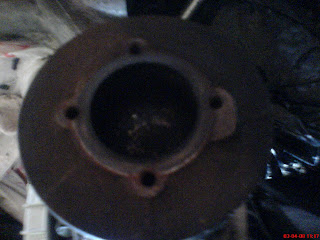Tuesday, 15 April 2008
The final stripdown to nuts and bolts
Friday, 4 April 2008
Removing the cylinder head, cylinder and exposing the piston
The engine, sitting in the middle of my front room

The cylinder, still intact

The cylinder head, after removal and scrubbing

The piston head, still in the cylinder, covered incarbon and other crud

The piston, once the cylinder head has been removed
Now I've had quite a lot of problems with removing the ~30 years of grime coaating this engine. I've been recommended using:
1. Household oven cleaner, which I tried. As it was water based, it made the exposed metalwork rust. not good.
2. WD40, which I tried. Though there's no rust, it sticks to the engine and doesnt wash the crud away.
3. Petrol, which I'm tring at the moment. Seems most effective actually. The combination of a petrol bath, a wire brush and a toothbrush for finer detail work seems to remove the most crud so far, but it is by no means perfect. My cylinder is still covered in crap.
The cylinder in a bucket of petrol, with a toothbrush sticking out of it
Wednesday, 2 April 2008
Stripping down the engine, and scraping off the paint
IF YOU DO THIS DO IT OUTSIDE OR YOU WILL DESTROY YOUR HOUSE. As I did....
This morning, as my car is laid up (bloody DVLA) I removed the rear wheel, exhaust pipe, exhaust manifold and carb manifold. Tonight I plan on taking the head off of the cylinder and having a look inside.

Out with the carb... What the hell it this?
Tuesday, 1 April 2008
The engine is out
After disconnecting the gear, clutch and rear brake cables, disconnecting the carb and removing the two pivot bolts from the engine, she dropped from the frame intact. Super. My major problems were removing the petrol tank to get at the carb. The previous owner had attached the petcock with a bent nail so it was a proper bugger to remove. Also, i'm pretty sure my carb isnt spec either i.e. not Dell'orto manufactured. This isnt a major problem because as soon as I get the bike running im going to slap a big fat race carb on her....




Monday, 31 March 2008
Ok, Its a PL-170, what do I need to do to it?
First things first...




The VIN number on the chassis

A PL-170 in lovely red

Another PL-170. This is what I'm hoping for in the final product

A Motovespa T3, similar but with a different horncast







